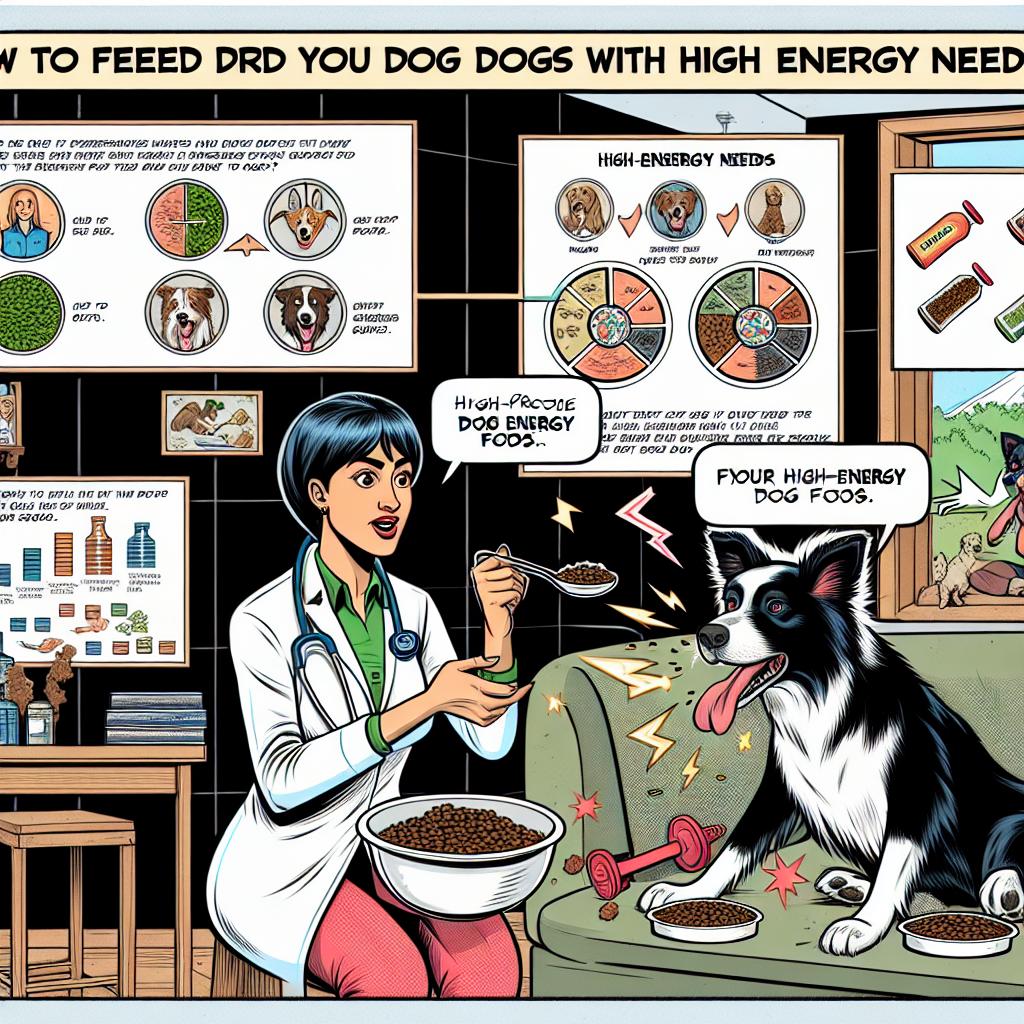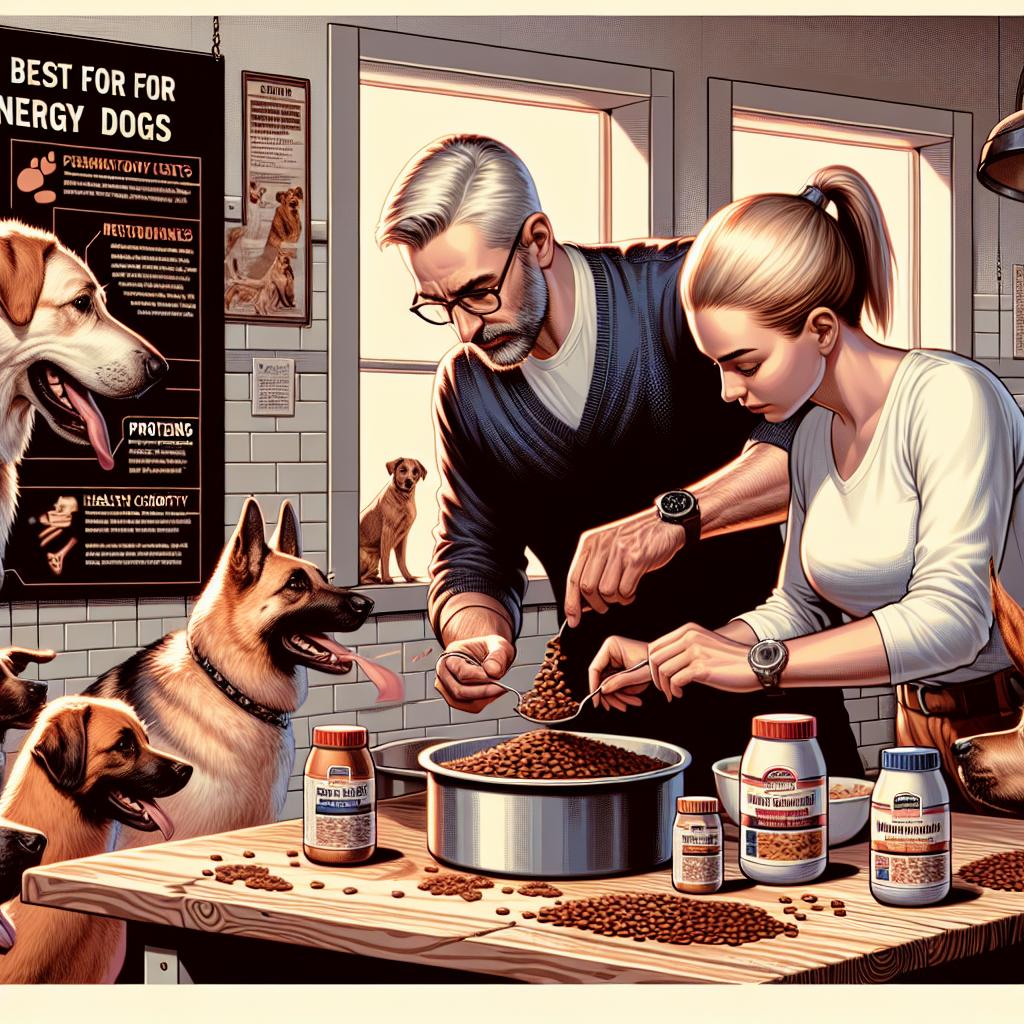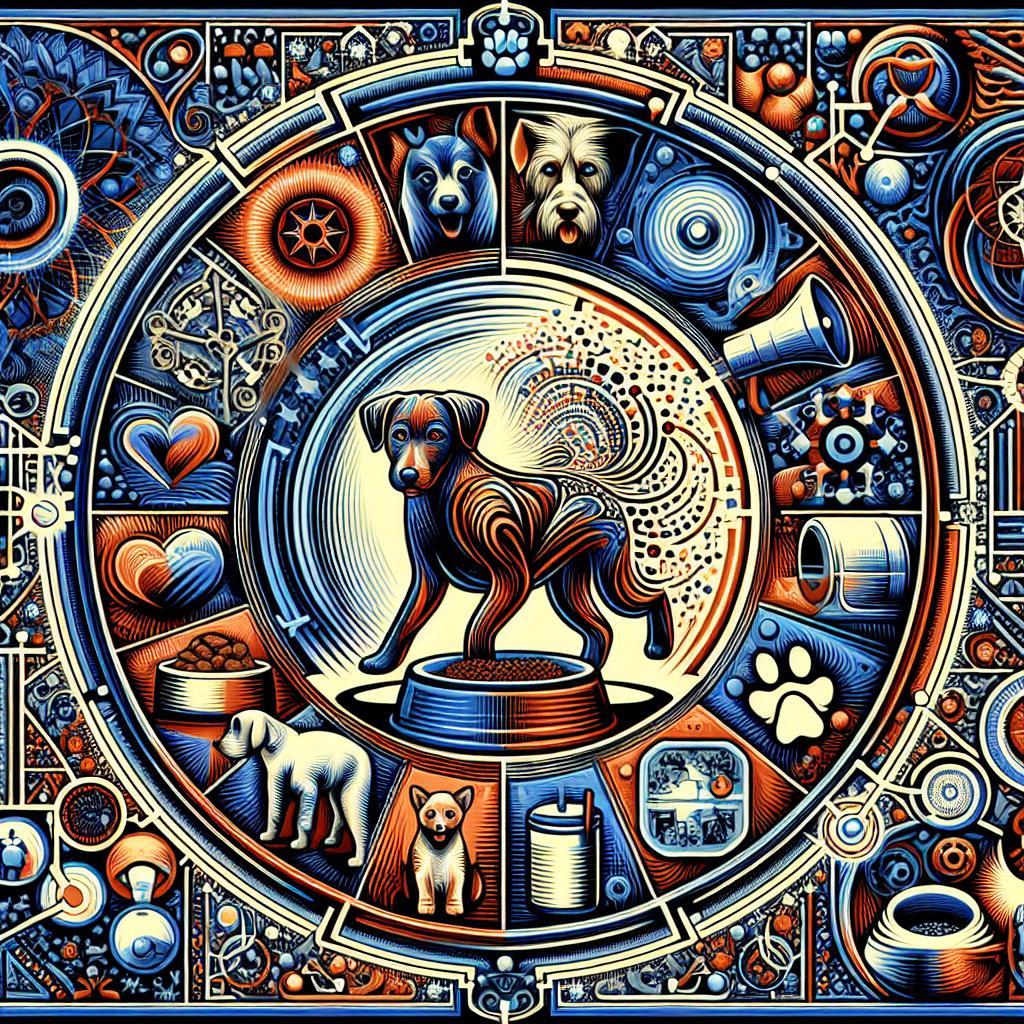How to Feed Dogs with High Energy Needs: A Balanced Approach to Nutrition
In a world where every wag of a tail and playful bark tells a story, our canine companions often embody boundless energy and enthusiasm. In contrast to their more laid-back counterparts, high-energy dogs—from the spirited Border Collie to the exuberant Labrador Retriever—demand a unique approach to their nutritional needs. These spirited pets thrive on activity, requiring not just ample physical exercise but also a diet that supports their vibrant lifestyles. As caretakers, understanding the intricacies of feeding these energetic furballs is essential in ensuring they remain healthy, happy, and ready for their next adventure. In this article, we’ll explore the vital components of a suitable diet for high-energy dogs, offering insights into optimal feeding strategies, ingredient selection, and tips for maintaining their overall well-being. Join us as we delve into the world of canine nutrition tailored specifically for those who leap, run, and bounce through life with uncontainable joy.
Understanding High Energy Needs in Dogs
Dogs with high energy needs typically belong to active breeds or those that engage in rigorous activities such as agility training, herding, or long-distance running. Their metabolism is significantly higher than that of average dogs, requiring a careful expansion of their diet to meet their lifestyle. It’s essential to provide a well-balanced diet rich in proteins and fats, as these macronutrients assist in muscle repair and provide sustained energy. Some common ingredients to consider include:
- High-quality animal proteins: Chicken, beef, lamb, and fish
- Healthy fats: Fish oil, chicken fat, and flaxseed
- Complex carbohydrates: Sweet potatoes, brown rice, and oats
Additionally, the feeding schedule plays a crucial role in supporting their energy levels throughout the day. Instead of one large meal, consider splitting their daily intake into multiple servings. This not only aids in digestion but helps provide a constant supply of energy. Below is a simple feeding guideline based on activity level:
| Activity Level | Daily Feeding Recommendation |
|---|---|
| Low (Casual walk) | 1.5 – 2% of body weight |
| Moderate (Regular walks/runs) | 2 – 3% of body weight |
| High (Agility/Competitive sports) | 3 – 5% of body weight |

Choosing the Right Nutrition for Active Breeds
When it comes to fueling active breeds, it’s essential to consider their unique dietary requirements. These dogs typically have higher energy needs due to their vigorous activity levels, which means their nutrition must be carefully balanced. A diet rich in high-quality proteins, healthy fats, and a variety of vitamins and minerals is crucial. Focus on ingredients that provide sustained energy, such as:
- Animal-based proteins: Look for chicken, beef, or fish as primary ingredients.
- Complex carbohydrates: Include whole grains or legumes to support endurance.
- Omega fatty acids: Ensure the inclusion of sources like fish oil for healthy joints and fur.
A well-structured meal plan can make all the difference in maintaining your dog’s health and performance. Consider portioning their meals to fit their activity levels throughout the day, factoring in pre- and post-exercise nutrition. Additionally, it’s important to monitor body condition and adjust food intake as needed. To illustrate how nutrition contributes to different energy levels in active breeds, here’s a simple comparison of nutrient content:
| Food Type | Protein (%) | Fat (%) | Carbohydrates (%) |
|---|---|---|---|
| Premium Dry Kibble | 30 | 15 | 50 |
| Raw Meat Diet | 40 | 20 | 10 |
| High-Performance Dog Food | 35 | 25 | 40 |

Incorporating Supplements for Enhanced Vitality
To support the active lifestyles of energetic dogs, incorporating the right supplements can play a crucial role in enhancing their vitality. These supplements can fill nutritional gaps and provide essential nutrients that high-energy dogs require. Some beneficial supplements include:
- Omega-3 Fatty Acids: Helps reduce inflammation and supports joint health.
- Probiotics: Aids in digestion and promotes a healthy gut, which is vital for overall energy.
- Glucosamine: Supports joint function and mobility, ensuring your dog stays active without discomfort.
- Multivitamins: Offers a broad spectrum of nutrients to bolster overall health.
When selecting supplements, it is essential to consider the specific needs of your dog. A tailored approach will ensure that they receive the optimal benefits. You might find it helpful to review formulations that meet the unique dietary requirements of your furry friend. An easy way to compare options is by examining the nutrient profiles in a simple table format:
| Supplement | Main Benefit | Recommended Dosage |
|---|---|---|
| Omega-3 | Anti-inflammation | 1000 mg/day |
| Probiotics | Digestive Health | 1-2 billion CFUs/day |
| Glucosamine | Joint Support | 500 mg/day |
| Multivitamin | Overall Nutritional Balance | 1 tablet/day |

Crafting a Balanced Feeding Schedule for Optimal Performance
Building a feeding schedule that fuels your high-energy dog requires a thoughtful approach, especially when considering their activity levels throughout the day. A consistent routine helps in regulating their metabolism and ensuring they receive the necessary nutrients. To create a balanced schedule, consider the following:
- Meal Frequency: Dividing their daily food into two or three meals can help maintain energy levels and prevent digestive issues.
- Timing: Align meals with their activity schedule. For example, feed them before intense exercise to prepare them for performance, and afterward to promote recovery.
- Portion Control: Assess their energy expenditure to determine the suitable portion sizes. A high-energy dog may require more calories, but balance is crucial to avoid obesity.
Incorporating high-quality protein and carbohydrates into their diet is essential for endurance and muscle recovery. Additionally, consider the role of snacks and treats in their overall diet. Here’s a simple table to give you a quick reference for your dog’s feeding schedule:
| Time | Activity Level | Meal/Snack |
|---|---|---|
| 7:00 AM | Moderate | Breakfast |
| 11:00 AM | High | Snack |
| 1:00 PM | Low | Lunch |
| 5:00 PM | High | Post-Exercise Dinner |
Adapting this framework as necessary for your dog will help them achieve optimal performance and healthy growth. Regularly assess their physical condition and energy levels to adjust the meal schedule as needed.
Q&A
Q&A: How to Feed Dogs with High Energy Needs
Q1: What exactly qualifies a dog as having high energy needs?
A: Dogs that exhibit high energy needs typically include working breeds, athletes, and highly active pets. These dogs often engage in rigorous activities such as running, agility training, or herding. Breeds like Border Collies, Siberian Huskies, and Labrador Retrievers often fall into this category. Their energy needs can be higher due to their size, activity level, and metabolism.
Q2: How can I assess my dog’s energy needs?
A: Assessing a dog’s energy needs involves observing their activity level and behavior. If your dog seems restless, requires longer play sessions, or constantly seeks stimulation, it might indicate higher energy needs. Additionally, consult your veterinarian to evaluate their specific requirements based on factors like age, weight, and overall health.
Q3: Should I change my dog’s diet if they have high energy needs?
A: Absolutely! Dogs with high energy requirements usually benefit from a diet that includes a higher calorie content, often in the form of quality proteins and fats. Look for dog foods specifically formulated for active or working dogs. These foods often contain added nutrients that support energy output and muscle recovery.
Q4: What are ideal ingredients to look for in a high-energy dog food?
A: When seeking suitable dog food, prioritize high-quality animal proteins (like chicken, lamb, or fish), healthy fats (such as chicken fat or fish oil), and easily digestible carbohydrates (like brown rice or sweet potatoes). Additionally, ingredients that provide omega fatty acids and antioxidants are beneficial for maintaining a healthy coat and boosting overall vitality.
Q5: How many meals should high-energy dogs eat throughout the day?
A: For high-energy dogs, splitting their daily food intake into two or more meals can be beneficial. This practice helps maintain energy levels throughout the day and can prevent bloating, especially in larger breeds. Consulting with your veterinarian can help you determine the best feeding schedule for your specific dog.
Q6: Are there any specific feeding techniques to enhance my dog’s nutrition?
A: Yes, consider incorporating feeding techniques that encourage mental stimulation and slower eating, such as puzzle feeders or slow bowls. This not only aids digestion but also provides a fun activity for your high-energy pup. Additionally, mixing in healthy snacks or treats, like fresh fruits or vegetables, can provide variety while contributing to their energy levels.
Q7: How can I tell if my dog is thriving on their high-energy diet?
A: Signs that your dog is thriving include a shiny coat, healthy weight, bright eyes, and consistent energy levels throughout the day. If your pup seems more focused, enjoys playtime, and recovers well after activities, that’s a good indication that their diet is meeting their needs. Regular check-ups with your veterinarian will also help ensure their nutritional requirements are being met.
Q8: What should I avoid feeding my high-energy dog?
A: Avoid foods that are low in nutrients, such as those with excessive fillers (like corn or wheat), artificial preservatives, or low-quality ingredients. Additionally, refrain from giving your dog excessive treats or human food that could lead to obesity or digestive issues. Maintaining a balanced and nutritious diet is essential for their energetic lifestyle.
Q9: When should I consult a veterinarian regarding my dog’s diet?
A: It’s prudent to consult a veterinarian if you notice significant changes in your dog’s energy levels, appetite, or weight. They can offer tailored advice based on your dog’s individual needs and lifestyle. Regular vet check-ups ensure that their diet and overall health stay on track, especially when dealing with high-energy requirements.
Q10: Any final tips for feeding high-energy dogs?
A: Stay observant and flexible. Each dog is unique, and their dietary needs may change over time based on age, activity levels, and health status. Keeping a keen eye on your dog’s behavior and energy can guide adjustments in their diet. Remember, a well-fed dog is a happy, energetic companion!
In Retrospect
As we conclude our exploration into the world of feeding dogs with high energy needs, it’s clear that understanding your furry friend’s nutritional requirements is pivotal in keeping their spirits and vitality soaring. Whether your companion is an agile athlete, a hard-working service dog, or simply a lively pet with boundless enthusiasm, the right diet can make all the difference. By choosing high-quality ingredients, meeting their specific caloric intake, and ensuring a balanced diet tailored to their unique lifestyle, you’re not just nourishing their bodies—you’re fueling their passions and adventures.
Remember, every dog is distinct, and what works for one may not be ideal for another. Always consult with a veterinarian or a pet nutrition specialist to craft the perfect feeding plan for your energetic friend. With a little dedication and the proper knowledge, you’re poised to enrich their lives and enhance the wonderful bond you share. Here’s to many joyful days of wagging tails and playful leaps, all supported by a diet that meets their high-energy demands!

